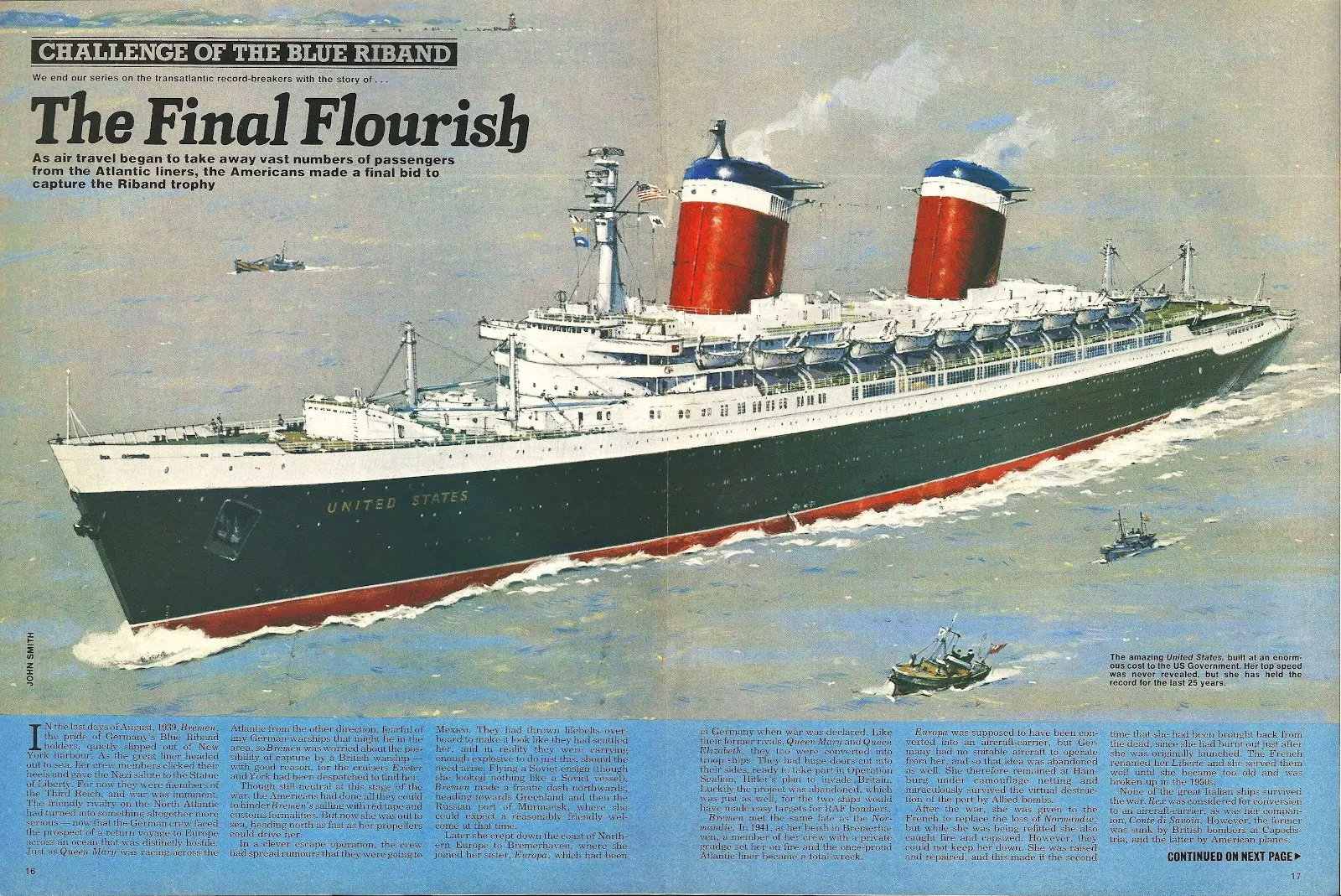The Paddle~Boat Pioneers. During the 1860s, screw-driven vessels replaced the paddlers. Samuel Cunard’s Britannia was for many years the fastest ship on the North Atlantic routes. Nothing captured the rivalry and spirit of the pioneering days of Atlantic travel more than the Blue Riband – the trophy awarded to the ship to cross the Atlantic in the fastest time. The very first ship to use steam all the way was Britain’s Sirius whose exploits are described in this opening article of our new series. Look and Learn Mag. No 856, 10th June 1978
The Duel That Led To Disaster. E.R. Collins’ wife and childrens were among those who drowned when the Arctic sank after a collision with a French steamer in 1854. When an American set out to wrest the Blue Riband from Cunard, he could not have known what it would cost him. Look and Learn Mag. 1978-06-17
Rule Britannia! During the 1860s, screw-driven vessels replaced the paddlers. Here Cunard’s Russia leads Inman’s City of Paris. For forty glorious years, British ships and shipbuilders dominated the sea-routes across the North Atlantic. Look and Learn Mag. 1978-06-24
The German Giants. The Kaiser Wilhelm der Grosse was the first German ship to win the Blue Riband. For years the Germans had taken a back seat while Britain dominated the Atlantic – however, there was no stopping them once they had set their sights on the Blue Riband. Look and Learn Mag. 1978-07-01
Voyage To Tragedy. Cunard’s record-breaking Lusitania was torpedoed off Southern Ireland in 1915. The sinking of the Lusitania by a German submarine in 1915 ended one of the most famous partnerships in the history of the Blue Riband. Look and Learn Mag. 1978-07-08
Transatlantic Showdown. One of the North Atlantic’s gracefull liners was the Rex, which gained the Blue Riband for Italy in 1932. As the great liners were vying with each other for the honour of making fastest transatlantic crossing, the stage was being set for keenest contest of all times. Look and Learn Mag. 1978-07-15
The Warrior Queens. In 1942, a huge wave struck Queen Mary broadside-on. Miraculously, she righted herself, but it was later estimated that if she had gone over another ten centimeters she would have sunk. When Cunard’s two crack liners, Queen Mary and Queen Elizabeth, were pressed into service as troop-carriers, their orders were to stop for nothing. Look and Learn Mag. 1978-07-22
The Final Flourish. The amazing United States, bilt in enormous cost to the US Government. Her top speed was never reveald. But she has held the record for the last 25 years. As air travel began to take away vast number of passengers from the Atlantic liners, the Americans made a final bid to capture the Riband trophy. Look and Learn Mag. 1978-07-29
John S. Smith – was a British marine painter, poster artist and illustrator. Christopher Deakes in his book reports that John S. Smith was trained as a graphic artist, and served throughout WW2 in the Royal Navy. After that the artist worked as a poster artist, easel painter, and designed periodicals and books. In the 1970-80s, John S. Smith illustrated the weekly for young people “Look and Learn” where the artist’s potential as an illustrator-storyteller was revealed with unprecedented force.

Представленные иллюстрации журнала "Лук энд лёрн" (Look and Learn) взяты из коллекции Ausdew’s Flickr
Дополнительно по теме: Look and Learn Magazine 1978-6-10 - 1978-07-29, The Challenge of the Blue Riband; Семён Исаакович Белкин. Голубая лента Атлантики / 1-е изд., Ленинград: Судостроение, 1967; Лев Николаевич Скрягин. По следам морских катастроф / Москва: Мор. транспорт, 1961; Blue Riband from Wikipedia, the free encyclopedia







